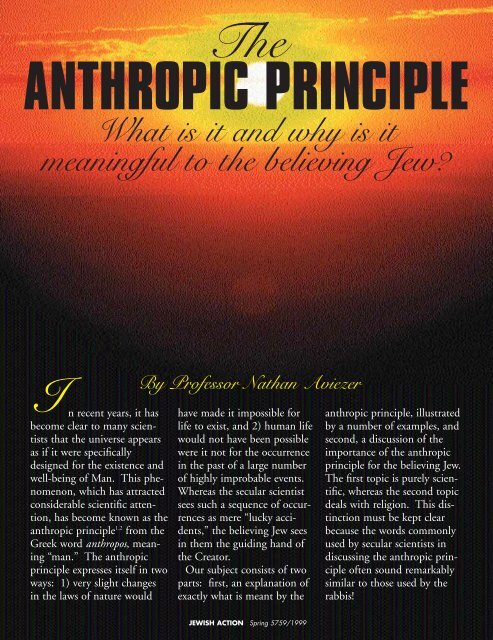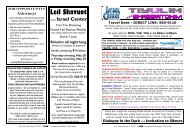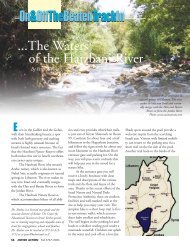The Anthropic Principle
The Anthropic Principle
The Anthropic Principle
Create successful ePaper yourself
Turn your PDF publications into a flip-book with our unique Google optimized e-Paper software.
<strong>The</strong><br />
ANTHROPIC PRINCIPLE<br />
What is it and why is it<br />
meaningful to the believing Jew?<br />
In recent years, it has<br />
become clear to many scientists<br />
that the universe appears<br />
as if it were specifically<br />
designed for the existence and<br />
well-being of Man. This phenomenon,<br />
which has attracted<br />
considerable scientific attention,<br />
has become known as the<br />
anthropic principle 1,2 from the<br />
Greek word anthropos, meaning<br />
“man.” <strong>The</strong> anthropic<br />
principle expresses itself in two<br />
ways: 1) very slight changes<br />
in the laws of nature would<br />
By Professor Nathan Aviezer<br />
have made it impossible for<br />
life to exist, and 2) human life<br />
would not have been possible<br />
were it not for the occurrence<br />
in the past of a large number<br />
of highly improbable events.<br />
Whereas the secular scientist<br />
sees such a sequence of occurrences<br />
as mere “lucky accidents,”<br />
the believing Jew sees<br />
in them the guiding hand of<br />
the Creator.<br />
Our subject consists of two<br />
parts: first, an explanation of<br />
exactly what is meant by the<br />
anthropic principle, illustrated<br />
by a number of examples, and<br />
second, a discussion of the<br />
importance of the anthropic<br />
principle for the believing Jew.<br />
<strong>The</strong> first topic is purely scientific,<br />
whereas the second topic<br />
deals with religion. This distinction<br />
must be kept clear<br />
because the words commonly<br />
used by secular scientists in<br />
discussing the anthropic principle<br />
often sound remarkably<br />
similar to those used by the<br />
rabbis!<br />
JEWISH ACTION Spring 5759/1999
<strong>The</strong> Laws of<br />
Nature and the<br />
Existence of Life<br />
<strong>The</strong> anthropic principle refers to the<br />
recent discovery of a remarkable connection<br />
between the laws of nature and<br />
the existence of life. It was previously<br />
thought that these two subjects have<br />
little in common. One can understand<br />
that the principles of biology would be<br />
related to the existence of life, but<br />
surely not the physical sciences. It is<br />
now known that such is not the case.<br />
Indeed, recent scientific discoveries<br />
have shown that the very existence of<br />
living creatures is intimately dependent<br />
on the details of the laws of physics,<br />
astronomy and cosmology.<br />
Solar Energy<br />
It is not necessary to elaborate on<br />
the fact that life on Earth is crucially<br />
dependent on the sun, whose heat and<br />
light are the primary source of all terrestrial<br />
energy (aside from radioactivity,<br />
which is not relevant to our discussion).<br />
Without solar energy, our planet<br />
would be incapable of supporting<br />
life. <strong>The</strong>refore, we begin our discussion<br />
of the anthropic principle by<br />
examining the mechanism that produces<br />
the sun’s energy.<br />
<strong>The</strong> sun contains only two kinds of<br />
atoms: hydrogen and helium. Helium<br />
is inert, unconnected to solar energy,<br />
and therefore need not concern us further.<br />
Our discussion centers on hydrogen,<br />
the simplest atom of all, whose<br />
nucleus consists of only one particle —<br />
a proton. Thus, the sun is basically a<br />
vast assemblage of protons. How these<br />
protons produce solar energy was first<br />
explained in the late 1930s by<br />
Professor Hans Bethe, who was awarded<br />
the Nobel Prize for his discovery.<br />
(Bethe was a German Jew who, like so<br />
many others, was dismissed from his<br />
university post by the Nazis in 1933.<br />
He eventually settled in the United<br />
States and joined the physics faculty of<br />
Cornell University, where he made his<br />
Nobel-prize-winning discovery.)<br />
Because of the extreme conditions<br />
present in the interior of the sun, a<br />
proton may occasionally transform<br />
spontaneously into a neutron —<br />
another fundamental particle of<br />
nature. <strong>The</strong> resulting neutron can<br />
combine with another proton to form<br />
a composite particle known as a<br />
deuteron. <strong>The</strong>se deuterons “burn” via<br />
a thermonuclear reaction and this<br />
“burning” provides the intense heat<br />
and brilliant light of the sun. Thus,<br />
deuterons constitute the solar fuel that<br />
generates the energy of the sun which<br />
enables life to exist on Earth.<br />
A very important feature of solar<br />
“burning” is that it occurs very gradually.<br />
Since neutrons are only rarely<br />
formed from protons, a relatively small<br />
number of deuterons are produced at<br />
any one time, and thus solar fuel<br />
(deuterons) constitutes but a tiny fraction<br />
of the total material in the sun.<br />
This ensures that the sun “burns” slowly,<br />
generating solar energy only gradually.<br />
Another possible nuclear reaction<br />
that could, in principle, take place is<br />
the combination of one proton with<br />
another proton. Fortunately for us,<br />
however, proton-proton combination<br />
does not occur. If one proton would<br />
have been able to combine with another<br />
proton, then all the protons in the<br />
sun would immediately combine with<br />
each other, leading to a gigantic explosion<br />
of the entire sun.<br />
<strong>The</strong> possibility of proton-neutron<br />
combination and the impossibility of<br />
proton-proton combination both<br />
depend on the strength of the<br />
“nuclear force,” one of the fundamental<br />
forces in nature (the other<br />
fundamental forces include the<br />
familiar force of gravity and the<br />
electromagnetic force). Detailed<br />
calculations 3 of the nuclear force<br />
have demonstrated the following<br />
results:<br />
1. If the nuclear force were only<br />
a few percent weaker, then a proton<br />
could not combine with a neutron<br />
to form a deuteron. If this were<br />
the case, no deuterons would be<br />
formed in the sun and hence no solar<br />
JEWISH ACTION Spring 5759/1999<br />
fuel would exist. As a result, the sun<br />
would not shine (“burn”), but would<br />
merely be a cold ball of inert gas —<br />
precluding the possibility of life on<br />
Earth.<br />
2. If the nuclear force were only a few<br />
percent stronger, then each proton<br />
would rapidly combine with another<br />
proton with explosive results. If this<br />
were the case, the sun would soon<br />
explode and thus cease to “burn,” once<br />
again precluding the possibility of life<br />
on Earth.<br />
It is an extraordinary fact that the<br />
strength of the nuclear force just happens<br />
to lie in the narrow range in<br />
which neither of these two catastrophes<br />
occurs. This is our first example<br />
of the anthropic principle.<br />
Water and Air on Our Planet<br />
It is not necessary to elaborate on<br />
the necessity of water and air for the<br />
existence of life. <strong>The</strong> Earth is blessed<br />
with an abundant supply of both, permitting<br />
life to flourish here, whereas<br />
our two neighboring planets, Venus<br />
and Mars, are both devoid of water<br />
and air, and hence devoid of life, as the<br />
space program has established. <strong>The</strong>se<br />
facts may not seem particularly noteworthy,<br />
but we shall see just how<br />
remarkable they really are.<br />
It was recently discovered that,<br />
shortly after they were formed, all<br />
three planets (Earth, Venus and Mars)<br />
had large amounts of surface water.
<strong>The</strong> deep channels that are observed<br />
today on the surface of Mars were<br />
carved out long ago by the copious<br />
fast-flowing Martian primordial surface<br />
waters. 4 Similarly, Venus was once<br />
covered by deep oceans which contained<br />
the equivalent of a layer of<br />
water three kilometers deep over its<br />
entire surface. 5 However, in the course<br />
of time, all surface waters on Mars and<br />
Venus disappeared. How did the<br />
Earth escape this catastrophe?<br />
<strong>The</strong> answer is that the Earth escaped<br />
this catastrophe by sheer “accident!”<br />
<strong>The</strong> Earth just happens to be sufficiently<br />
distant from the sun that our<br />
surface water neither evaporated nor<br />
decomposed, as happened on Venus.<br />
Moreover, the Earth just happens to be<br />
sufficiently near the sun that the temperature<br />
remains high enough to prevent<br />
all the oceans from freezing permanently,<br />
as happened on Mars.<br />
<strong>The</strong>refore, the Earth alone, among the<br />
planets of the solar system, is capable<br />
of supporting life.<br />
Similar remarks apply to the atmosphere.<br />
Recent studies of the carbonatesilicate<br />
geochemical cycle have shown<br />
that the planetary atmosphere is controlled<br />
by a very delicate balance,<br />
involving the subtle interplay of many<br />
factors. 6 This balance is so delicate that<br />
if the Earth were only a few percent<br />
closer to the sun, surface temperatures<br />
would be far higher than the boiling<br />
point of water, precluding all possibility<br />
of a life-sustaining atmosphere.<br />
Similarly, if the Earth were only a few<br />
percent farther from the sun, the concentration<br />
of carbon dioxide in the<br />
atmosphere would become so high that<br />
“the atmosphere would not be breathable<br />
by human beings.” 7 Fortunately,<br />
the orbit of the planet Earth just happens<br />
to lie at the crucial distance from<br />
the sun that permits the formation of a<br />
life-sustaining atmosphere. (“Life could<br />
appear in this extremely narrow zone.” 8 )<br />
This remarkably fortunate coincidence<br />
is known among scientists as<br />
“the Goldilocks problem of climatology.”<br />
Recall the children’s story in<br />
which Goldilocks found the various<br />
items of Baby Bear to be “not too hot<br />
and not too cold, not too hard and not<br />
too soft, but just right.” In that vein,<br />
scientists refer to the existence of water<br />
and air on Earth as another example of<br />
the anthropic principle.<br />
Physics and Astronomy<br />
<strong>The</strong> above two examples of the<br />
anthropic principle are taken from<br />
among the many that could be<br />
brought from the physical sciences.<br />
Indeed, the examples are so numerous<br />
and so dramatic that many scientists<br />
have commented on the severe<br />
restraints that the existence of life<br />
places on the laws of nature. Particularly<br />
perceptive are the impressions of<br />
Professor Freeman J. Dyson 9 of the<br />
Institute for Advanced Study in<br />
Princeton, one the world’s leading<br />
mathematical physicists, whose words<br />
capture the essence of the anthropic<br />
principle:<br />
As we look out into the universe and<br />
identify the many peculiarities of physics<br />
and astronomy that have worked together<br />
for our benefit, it almost seems as if<br />
the universe must in some sense have<br />
known that we were coming.<br />
JEWISH ACTION Spring 5759/1999<br />
<strong>The</strong> Origin of Life<br />
<strong>The</strong> branch of science dealing with<br />
the origin of life is called molecular<br />
biology. <strong>The</strong>re has been enormous<br />
progress in the past few decades.<br />
Scientists have unraveled the structure<br />
of DNA (the long, thread-like molecules<br />
that form the genetic material<br />
found in each cell of every living creature)<br />
— the famous double helix. <strong>The</strong><br />
genetic code has been deciphered. <strong>The</strong><br />
hundreds of complex chemical reactions<br />
that take place within the cell are<br />
now understood. From all this scientific<br />
progress, one could easily form the<br />
impression that the “riddle of life” has<br />
been solved, i.e., that scientists have<br />
succeeded in explaining all the steps by<br />
which inanimate material became<br />
transformed into the complex biological<br />
systems that we call “life.”<br />
However, such a conclusion would be<br />
completely erroneous.<br />
After half a century of intensive<br />
research into molecular biology, scientists<br />
have come to appreciate just how<br />
extremely improbable and incredible<br />
appears the transformation of inanimate<br />
material into living cells. This<br />
was the central theme of a recent<br />
Scientific American article, 10 appropriately<br />
entitled, “In the Beginning...” (I<br />
love that title!). This article describes,<br />
in detail, the enormous difficulties<br />
encountered by all current scientific<br />
proposals to explain the origin of life,<br />
quoting leading experts in the field.<br />
Professor Harold Klein, 11 chairman<br />
of the U.S. National Academy of<br />
Sciences Committee that reviewed origin-of-life<br />
research, is quoted by<br />
Scientific American as follows: <strong>The</strong><br />
simplest bacterium is so damn complicated<br />
that it is almost impossible to imagine<br />
how it happened.<br />
Professor Francis Crick, 12 who<br />
shared the Nobel Prize for discovering<br />
the structure of DNA, is also quoted as<br />
using picturesque language: <strong>The</strong> origin<br />
of life appears to be almost a miracle, so<br />
many are the conditions which would<br />
have had to be satisfied to get it going.<br />
If this Nobel laureate, known as a<br />
man completely devoid of any religious<br />
feeling, sees fit to use the words<br />
“almost a miracle” to describe the origin<br />
of life, it is clear that quite an<br />
incredible series of unlikely events<br />
must have occurred.<br />
Highly<br />
Improbable<br />
Events and<br />
Human Beings<br />
<strong>The</strong> Destruction of the Dinosaurs<br />
So far, we have been discussing the<br />
many unlikely events that were necessary<br />
to make possible the existence of<br />
life itself. But our main concern, of<br />
course, is with human life. <strong>The</strong>refore,<br />
we ask: Did any extremely unusual<br />
events have to occur to permit the existence<br />
of human beings? As we shall<br />
see, the scientists’ answer is a resounding<br />
“Yes!” This is the very heart of the
anthropic principle.<br />
We begin our analysis of the highly<br />
improbable events that culminated in<br />
human life with a discussion of the<br />
dinosaurs, those terrible monsters of<br />
the past. <strong>The</strong> dinosaurs were one of<br />
the most successful groups of animals<br />
that ever lived — the largest, strongest,<br />
fastest and fiercest animals of all time.<br />
<strong>The</strong> dinosaurs (and their close relatives)<br />
inhabited every continent, the air<br />
(flying dinosaurs) and the oceans<br />
(marine dinosaurs). Other animals<br />
lived in constant fear of being<br />
devoured or destroyed by these gigantic<br />
reptiles. Because the dinosaurs<br />
were the dominant form of animal life,<br />
this geological era is commonly<br />
referred to as the Age of Reptiles.<br />
After being the undisputed masters<br />
of our planet, all the dinosaurs worldwide<br />
suddenly became extinct. This<br />
sudden destruction of all the<br />
dinosaurs, together with most other<br />
animal species, is the most famous of<br />
the mass extinctions that have occurred<br />
periodically in the history of our planet,<br />
each time abruptly wiping out the<br />
majority of animal species. <strong>The</strong> cause<br />
of this mass extinction had baffled scientists<br />
for many years. What could<br />
have caused the abrupt demise of these<br />
extremely successfully animals after<br />
they had enjoyed such a long period of<br />
dominance? What occurred to suddenly<br />
wipe out the dinosaurs?<br />
After years of debate, the riddle of<br />
what caused the sudden and total<br />
destruction of the dinosaurs was finally<br />
solved in 1980 by Nobel laureate Luis<br />
Alvarez and his son Walter, who<br />
showed that a giant meteor from outer<br />
space had collided with the Earth to<br />
cause this worldwide catastrophe. 13<br />
This explanation for the mass extinctions<br />
— the impact of meteors or<br />
comets colliding with the Earth — has<br />
become known as the “impact theory.”<br />
<strong>The</strong> scientific evidence in favor of the<br />
impact theory accumulated rapidly,<br />
and by 1987, Professor Alvarez could<br />
point to 15 different pieces of scientific<br />
data that supported the theory. 14<br />
<strong>The</strong> point of central importance to<br />
our discussion is that the collision<br />
Our main<br />
concern,<br />
of course,<br />
is with<br />
human life.<br />
between the meteor and the Earth was<br />
a matter of sheer luck. This has been<br />
repeatedly stressed by the leading paleontologists.<br />
For example, Professor<br />
David Raup, past president of the<br />
American Paleontological Society, has<br />
taken precisely this point as the central<br />
theme of his famous article (since<br />
expanded into a book with same title),<br />
Extinctions: Bad Genes or Bad Luck? In<br />
his article, Raup 15 emphasizes the role<br />
played by “luck” in mass extinctions:<br />
<strong>The</strong> extinction of a given species or higher<br />
group is more bad luck than bad<br />
genes. Pure chance would favor some<br />
biologic groups over others.<br />
<strong>The</strong> important role played by luck in<br />
mass extinctions has also been emphasized<br />
by Professor Stephen J. Gould 16<br />
of Harvard University, one of the<br />
world’s leading authorities on evolutionary<br />
biology: If extinctions can<br />
demolish more than 90% of all species,<br />
then we must be losing groups forever by<br />
pure bad luck.<br />
Professor George Yule 17 of the<br />
University of Oxford puts it in the following<br />
way:<br />
<strong>The</strong> species exterminated were not killed<br />
out because of any inherent defects, but<br />
simply because they had the ill-luck to<br />
stand in the way of the cataclysm.<br />
Finally, we quote Professor David<br />
Jablonski 18 of the University of<br />
Chicago, a world authority on the subject<br />
of mass extinctions: When a mass<br />
extinction strikes, it is not the “most fit”<br />
JEWISH ACTION Spring 5759/1999<br />
species that survive; it is the most fortunate.<br />
Species that had been barely hanging<br />
on...inherit the earth.<br />
<strong>The</strong>se leading paleontologists are<br />
emphasizing that if a giant meteor suddenly<br />
falls from the sky and wipes out<br />
some species, while permitting other<br />
species to survive and ultimately to<br />
flourish, then the latter species were<br />
blessed with good luck — the occurrence<br />
of an extremely improbable and<br />
totally unexpected event. <strong>The</strong><br />
Darwinian principle of “the survival of<br />
the fittest” is irrelevant in such a<br />
process.<br />
<strong>The</strong> Dinosaurs and Man<br />
Why is the sudden destruction of all<br />
the dinosaurs worldwide a dramatic<br />
example of the anthropic principle? As<br />
long as the dinosaurs dominated the<br />
Earth, there was no possibility for large<br />
mammals to exist. Only after the<br />
dinosaurs were wiped out could the<br />
mammals flourish and become the<br />
dominant fauna.<br />
This intimate connection between<br />
human beings and the dinosaurs was<br />
emphasized by Professor Alvarez, 19<br />
who ends his article about the abrupt<br />
destruction of all the world’s dinosaurs<br />
due to the impact of a gigantic meteor,<br />
with the following stirring words:<br />
From our human point of view, that<br />
impact was one of the most important<br />
single events in the history of our planet.<br />
Had it not taken place, the largest mammals<br />
alive today might still resemble the<br />
rat-like creatures that were then scurrying<br />
around trying to avoid being<br />
devoured by dinosaurs.<br />
But there is even more to the story.<br />
For human beings to exist today, it was<br />
not sufficient merely that such an<br />
impact with the meteor occurred. <strong>The</strong><br />
impact had to have occurred with just<br />
the right strength. As Professor<br />
Alvarez explains: 20 If the impact had<br />
been weaker, no species would have<br />
become extinct; the mammals would still<br />
be subordinate to the dinosaurs, and I<br />
[Alvarez] wouldn’t be writing this article.<br />
If the impact had been stronger, all<br />
life on this planet would have ceased,<br />
and again, I wouldn’t be writing this
article. That tells me that the impact<br />
must have been of just the right strength<br />
[to ensure that] the mammals survived,<br />
while the dinosaurs didn’t.<br />
Wonderful Life by S. J. Gould<br />
It has recently become clear to scientists<br />
that the sudden destruction of all<br />
the world’s dinosaurs was just one of a<br />
long series of completely unexpected,<br />
highly improbable events whose occurrence<br />
was necessary for human beings<br />
to exist — and all these events just<br />
happened to occur in precisely the<br />
required sequence. Indeed, this is a<br />
major theme in the recent book, entitled<br />
Wonderful Life, by Professor<br />
Gould. Again and again, Gould<br />
emphasizes how amazing it is that<br />
human beings exist at all, because, 21<br />
we are an improbable and fragile entity...the<br />
result of a staggeringly improbable<br />
series of events, utterly unpredictable<br />
and quite unrepeatable. His 320-page<br />
book abounds with examples of the<br />
anthropic principle. For example: 22<br />
It fills us with a kind of amazement<br />
(because of its improbability) that<br />
human beings exist at all. Replay the<br />
tape[of life] a million times from the<br />
same beginning, and I doubt that Homo<br />
sapiens would ever appear again. It is,<br />
indeed, a wonderful life.<br />
Calculating<br />
Probabilities<br />
Now that we have described in detail<br />
the scientific meaning of the anthropic<br />
principle, we turn to the second part<br />
of the discussion and ask: What are its<br />
implications?<br />
In particular, what are the implications<br />
for the Torah Jew? I would like<br />
to begin this part of the discussion on<br />
a personal note. A few years ago, I<br />
wrote a book on Biblical creation and<br />
science, titled In the Beginning, showing<br />
that current scientific evidence is in<br />
remarkable agreement with the Biblical<br />
account of the origin and development<br />
of the universe. My book has enjoyed<br />
a measure of success, and has been<br />
reprinted ten times and translated into<br />
Hebrew, Russian, French, Spanish,<br />
Portuguese and Norwegian.<br />
However, the book was not to everyone’s<br />
taste. Professor Raphael Falk, a<br />
geneticist at the Hebrew University<br />
and a militant secularist, was so outraged<br />
by my book that he published a<br />
ten-page article 23 devoted solely to<br />
attacking both my book and me personally<br />
(“fundamentalist,” “commits<br />
scientific rape,” “writes pseudo-science,”<br />
“manipulates facts,” etc.). In<br />
particular, Falk 24 ridiculed my discussion<br />
of the anthropic principle by<br />
means of the following counter-argument:<br />
Aviezer places particular emphasis<br />
on the “remarkable coincidences”<br />
which characterize the universe. <strong>The</strong><br />
point of this claim is that such remarkable<br />
events could not have occurred<br />
through chance, but rather are the result<br />
of a guiding hand. Superficially, this<br />
claim appears convincing, but a little<br />
thought shows that that it is without<br />
foundation. According to Aviezer’s logic,<br />
the probability that I am writing these<br />
lines with a dull yellow pencil, using my<br />
left hand, sitting at my kitchen table, on<br />
the third floor of a specific Jerusalem<br />
address — this probability is completely<br />
negligible. Nevertheless, all these events<br />
happened and they clearly mean nothing.<br />
It is important to explain what is<br />
wrong with Falk’s argument, because<br />
his error is not immediately obvious<br />
and, in fact, has been repeated by<br />
many other writers. For example, this<br />
same error appears in an article on the<br />
anthropic principle, 25 written by a distinguished<br />
philosopher who is also an<br />
observant Jew. This author brings the<br />
following example: “I pull a $1 note<br />
from my wallet and observe its serial<br />
number to be G65538608D...[probability<br />
for occurrence] was less than one<br />
in ten billion. Thus, undeniably, I am<br />
faced here with an extremely rare<br />
event...but I am not surprised. What is<br />
essential is to make the crucial distinction<br />
between improbable events that are<br />
genuinely surprising and those that are<br />
not.” (italics added)<br />
I have italicized the two erroneous<br />
statements. <strong>The</strong> first italicized statement<br />
is simply wrong. We shall soon<br />
see why we are not faced with a rare<br />
event. <strong>The</strong> second italicized statement<br />
is meaningless, because all improbable<br />
events are surprising. Indeed, that is<br />
what is normally meant by the word<br />
“surprising.”<br />
<strong>The</strong> key to understanding this topic<br />
can be found in the words of Nobel<br />
laureate Richard Feynman, one of the<br />
most brilliant physicists of the 20th<br />
Century. In his marvelous, popular<br />
book on quantum electrodynamics (in<br />
which he explains this most complex<br />
of theories simply and without the use<br />
of a single equation!), Feynman 26<br />
<strong>The</strong> same<br />
rare event<br />
can either be<br />
wondrous or<br />
meaningless.<br />
emphasizes: In order to calculate correctly<br />
the probability of an event, one<br />
must be very careful to define the event<br />
clearly.<br />
Following Feynman’s advice, we shall<br />
clearly define the event described<br />
above, which immediately leads to the<br />
conclusion that there is a probability of<br />
100% that the dollar note pulled from<br />
the wallet has G65538608D for its serial<br />
number! Why? Because this number<br />
was chosen by looking at the serial<br />
number on the $1 note. In other<br />
words, one was simply asking, “What<br />
is the probability that the serial number<br />
on the note is the serial number on<br />
the note?” And the answer to this<br />
question, clearly, is 100%. Since the<br />
event was not improbable at all — but<br />
JEWISH ACTION Spring 5759/1999
certain — there is no reason whatever<br />
to be surprised by its occurrence.<br />
One may now apply the same logic<br />
to invalidate Falk’s argument. What<br />
was the probability that Falk wrote his<br />
article on his kitchen table, using a<br />
dull yellow pencil held in his left hand,<br />
on the third floor of a specific<br />
Jerusalem address? <strong>The</strong> answer is:<br />
100%! Why? Because Falk chose<br />
these unusual conditions on the basis<br />
on what he already knew to have happened.<br />
In other words, he simply<br />
asked, “What is the probability that<br />
what I know to have happened, really<br />
did happen?” <strong>The</strong> answer is clearly<br />
100% — by definition.<br />
A rare, extremely improbable event<br />
occurs if one defines the conditions<br />
before knowing what will happen. For<br />
example, if one chooses a serial number<br />
before pulling the $1 note from<br />
the wallet, and then finds that the<br />
number chosen is exactly the same as<br />
the number on the note, we would all<br />
be absolutely astonished — and with<br />
good reason! Similarly, if Falk had<br />
guessed correctly all the conditions<br />
under which someone else had written<br />
an article, then we would all be flabbergasted<br />
— and rightly so.<br />
Events in Context - Playing the Lotto<br />
We now turn to the second important<br />
aspect of Feynman’s statement —<br />
events must be defined in context. An<br />
example will illustrate this point.<br />
Among the popular national lotteries<br />
in Israel is “Lotto.” Say, for example,<br />
that one million people buy a Lotto<br />
ticket each week. If I am informed<br />
that this week’s winner is Chaim<br />
Cohen from Afula, I will certainly not<br />
get very excited about it. But why<br />
not? <strong>The</strong> chances that Chaim Cohen<br />
would be the winner were only one in<br />
a million — and it happened! <strong>The</strong><br />
reason for my lack of excitement is the<br />
following. I could not care less if the<br />
Lotto winner is Chaim Cohen from<br />
Afula, Sarah Levi from Be’er Sheva or<br />
Shmerel Berel from Ramat Gan. In<br />
other words, each of the one million<br />
Lotto players is completely equivalent<br />
in my eyes to Chaim Cohen from<br />
Afula (the technical term for this in<br />
statistics is “equivalent microstates”).<br />
Although the chances were only one in<br />
a million that the winner would be<br />
Chaim Cohen from Afula, there exist<br />
one million “equivalent” Chaim<br />
Cohens. <strong>The</strong>refore, the substance of<br />
what I heard is that someone won the<br />
Lotto this week. And the chances for<br />
that event happening — someone winning<br />
— are 100%. Hence, I have no<br />
reason to be surprised.<br />
Now consider the following week. If<br />
I were informed that Chaim Cohen<br />
again won the Lotto, I would most<br />
certainly be amazed, and so would<br />
everyone else. But why? <strong>The</strong><br />
chances of Chaim Cohen winning<br />
the Lotto the second week were<br />
exactly the same as his chances of<br />
winning the first week. <strong>The</strong><br />
answer is that the context is<br />
entirely different. In the first<br />
week, Chaim Cohen was just<br />
one out of a million equivalent<br />
Lotto players. But in<br />
the second week, he has<br />
become a unique individual<br />
— the fellow who won last<br />
week. In other words, in the<br />
second week, there exists only<br />
one Chaim Cohen — only one<br />
previous week’s winner — and the<br />
chances of this unique individual winning<br />
the Lotto again are therefore truly<br />
one in a million. When such a rare<br />
event occurs, we are all genuinely surprised.<br />
Finally, we turn to the third week. If<br />
we were to learn that Chaim Cohen<br />
from Afula had again won the Lotto,<br />
for the third consecutive week, it is<br />
clear that suspicion, not surprise,<br />
would be the natural reaction. Indeed,<br />
there is little doubt that the fraud division<br />
of the police department would<br />
soon be paying Chaim Cohen a visit to<br />
discuss with him just how it happened<br />
that Chaim won the Lotto for three<br />
consecutive weeks. But why? <strong>The</strong><br />
chances of Chaim Cohen winning the<br />
Lotto in the third week were exactly<br />
the same as his chances of winning the<br />
first week. <strong>The</strong> answer again lies in the<br />
context of the event. In the third<br />
week, Chaim Cohen is an extremely<br />
unusual individual — the fellow who<br />
has already won the Lotto for two<br />
weeks running. <strong>The</strong> chances that this<br />
same person will win the Lotto once<br />
again are easily shown to be only one<br />
in a million millions. Such events are<br />
so rare that they simply do not occur.<br />
<strong>The</strong>refore, the police department correctly<br />
suspects that a guiding hand was<br />
behind Chaim Cohen’s triple win. A<br />
guiding hand in the creation of the<br />
universe means the intercession of the<br />
Almighty, but a guiding hand in the<br />
determination of the Lotto winner<br />
means five years in Ramla Prison!<br />
Events in Context — Playing Cards<br />
We next consider card games, beginning<br />
our discussion with the game of<br />
poker (in particular, five-card poker<br />
without a draw). In this game, each<br />
player is dealt five cards from the deck,<br />
and these cards form a combination<br />
(such as a pair, three-of-a-kind, a flush,<br />
etc.). Each combination has an agreed<br />
ranking, and the game is won by the<br />
player whose cards form the highest<br />
ranking combination.<br />
<strong>The</strong> highest ranking combination of<br />
cards in poker is the straight flush (it is<br />
not necessary to know what a straight<br />
flush is). A straight flush is so rare that<br />
JEWISH ACTION Spring 5759/1999
one can play poker all day, every day of<br />
his life, and never see one. And if a<br />
poker player should ever get a straight<br />
flush, he will never forget it. It’s the<br />
dream of every poker player!<br />
We now turn to a different card<br />
game: bridge. In this game, each player<br />
is dealt thirteen cards, but we will<br />
consider only the first five cards to<br />
enable us to make a comparison with<br />
poker. If a bridge player’s first five<br />
cards were to be the combination that<br />
constitutes a straight flush in poker, he<br />
would probably not even be aware of it<br />
because, in bridge, a “straight flush”<br />
has no value or meaning whatever.<br />
This combination of cards is not even<br />
defined in bridge, hence I put quotation<br />
marks around the words “straight<br />
flush.” Thus, we see that the exact<br />
same combination of cards is considered<br />
a wondrous combination in poker<br />
because of its rarity and value, but is<br />
considered a meaningless combination<br />
in bridge, despite its rarity, because it<br />
has no value.<br />
<strong>The</strong> <strong>Anthropic</strong><br />
<strong>Principle</strong> and the<br />
Believing Jew<br />
<strong>The</strong> preceding examples and discussion<br />
pave the way for the answer to<br />
our central question: What conclusions<br />
may one draw from the anthropic<br />
principle? <strong>The</strong> answer depends on<br />
one’s views regarding the significance<br />
of human beings. In our example<br />
about poker and bridge, we explained<br />
why the extremely rare straight flush is<br />
a wondrous event in a poker game, but<br />
a meaningless event in a bridge game.<br />
In other words, the same rare event<br />
can be either wondrous or meaningless:<br />
it all depends on the importance<br />
that one attributes to the event itself.<br />
Returning to the subject of our article<br />
— human beings — we saw that many<br />
extremely unlikely events (“a staggeringly<br />
improbable series of events...quite<br />
unrepeatable” 27 ) had to “occur” to make<br />
possible the appearance of human<br />
beings on Earth. Thus, the extreme<br />
rarity of the events leading to human<br />
existence is well established. Indeed,<br />
that is the scientific content of the<br />
anthropic principle. But before we can<br />
decide on the meaning of these events,<br />
we must first decide on the meaning of<br />
the end product — human beings.<br />
If humans are assumed to be just<br />
another species in the Animal Kingdom<br />
(as the secularists believe), not more<br />
important than any other of the<br />
approximately two million species discovered<br />
so far, then the anthropic principle<br />
has no meaning. We have seen<br />
that rarity by itself is not significant. It<br />
is a “straight flush” in bridge, rare and<br />
interesting, but without any meaning.<br />
If, however, one believes that human<br />
beings are the most important species<br />
in the world and that mankind is the<br />
entire reason for the creation of the<br />
universe — as the Torah and the Sages<br />
of the Talmud repeatedly emphasize<br />
— then the anthropic principle is<br />
of the utmost significance. It is a<br />
straight flush in poker, the most<br />
meaningful of occurrences.<br />
In summary, the scientists<br />
have discovered that, in the<br />
existence of human beings, the<br />
universe has dealt out the<br />
extremely rare straight flush.<br />
Everyone agrees with that; the<br />
anthropic principle has become a<br />
scientifically established fact. But<br />
the non-believer is “playing bridge”<br />
and therefore the anthropic principle<br />
JEWISH ACTION Spring 5759/1999<br />
means nothing to him. By contrast,<br />
the believing Jew is “playing poker”<br />
and therefore the anthropic principle is<br />
yet another example of the harmony<br />
that exists between modern science and<br />
words of the Torah. JA<br />
Professor Aviezer teaches physics at Bar-<br />
Ilan University, Ramat-Gan, Israel. In<br />
addition to In the Beginning: Biblical<br />
Creation and Science, mentioned above,<br />
he is the author of the forthcoming book,<br />
Physics, Fossils, and Faith (Ktav).<br />
NOTES<br />
1. J. D. Barrow and F. J. Tipler, <strong>The</strong> <strong>Anthropic</strong><br />
Cosmological <strong>Principle</strong> (Oxford: At the<br />
University Press, 1986).<br />
2. G. Gale, Scientific American, December<br />
1981, pp. 114-122.<br />
3. P. C. W. Davis, Journal of Physics, vol. 5,<br />
1972, pp. 1296-1304.<br />
4. J. Audouze et al., eds., <strong>The</strong> Cambridge Atlas<br />
of Astronomy (Cambridge: At the University<br />
Press, 1985), pp. 124-149.<br />
5. Ibid., pp. 70-81.<br />
6. J. F. Kasting et al., Scientific American,<br />
February 1988, pp. 46-53.<br />
7. Ibid., p. 53.<br />
8. J. Audouze et al., loc. cit., p. 63.<br />
9. F. J. Dyson, Scientific American, September<br />
1971, p. 59.<br />
10. J. Horgan, Scientific American, February<br />
1991, pp. 100-111.<br />
11. H. P. Klein, ibid., p. 104.<br />
12. F. Crick, ibid., p. 109.<br />
13. W. Alvarez et al., Science, vol. 223, March<br />
1984, pp. 1135-1140.<br />
14. L. W. Alvarez, Physics Today, July 1987, pp.<br />
24-33.<br />
15. D. M. Raup, Acta Geologica Hispanica, vol.<br />
15, 1981, pp. 25-33.<br />
16. S. J. Gould, <strong>The</strong> Flamingo’s Smile (W. W.<br />
Norton: New York, 1981), p. 242.<br />
17. G. U. Yule, Philosophical Transactions of the<br />
Royal Society of London, vol. 213, 1981, p. 24.<br />
18. D. Jablonski, quoted in National<br />
Geographic, June 1989, p. 673.<br />
19. L. W. Alvarez, loc. cit., p. 33.<br />
20. Ibid., p. 29.<br />
21. S. J. Gould, Wonderful Life (W. W.<br />
Norton: New York, 1989), pp. 14, 319.<br />
22. Ibid., p, 319.<br />
23. R. Falk, Alpai’im, vol. 9, Spring 1994, pp.<br />
133-142.<br />
24. Ibid., p. 136.<br />
25. G. N. Schlesinger, Tradition, vol. 23,<br />
Spring 1988, pp. 1-8.<br />
26. R. P. Feynman, QED (Princeton: At the<br />
University Press, 1985), p. 81.<br />
27. S. J. Gould, loc. cit., p. 14.
















